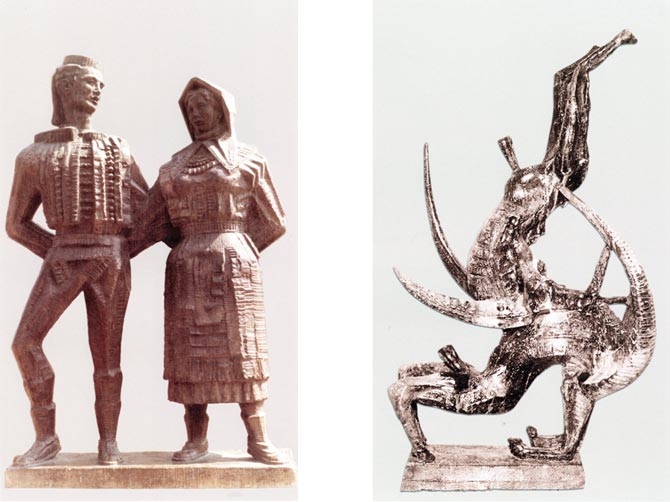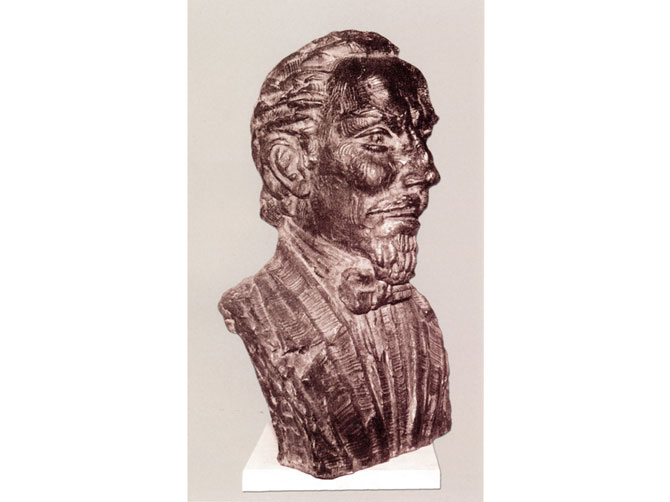Mile Grgas: sculptures and drawings
Author of the exhibition: Mile Grgas
Exhibition design: Joža Ladović
Taking a view of a sculpture created by Mile Grgas, we are at first thinking of its motivation, inspiration and source, of rocky (but dignified) soil of the artist's homeland as well as of his modelling power relying on the values found in our tradition, on Meštrović, Augustinčić, Kršinić, Lozica and others, known and less known phenomena and personalities of the Croatian art of modern times. This sculptor considers that it is possible by the use of a classical modelling and classical types of sculpture say much new and interesting even in today's art of sculpture, providing that an artist has his own vision of the world and life, his own “creative temperature” based on life and experience containing permanent human (and aesthetic) messages and testimonies. To live up the said experience, Mile Grgas was not compelled to make any effort: it was given to him by his own life and the nature arround him, Dalmatia and its landscape. The sculptor's task was just to transpose it into the suggestive speech of forms, into figures and bodies assuming new dimensions, new possibility of life and existence. However, it is at once necessary to emphasize that Mile Grgas is not attracted only by the physical and material stimuli he finds in his native milieu. The said milieu means much more to the artist because he constantly reveals in it also the spiritual reason of existence as such, in connection with the people, history, customs, etc. This artist is interested in the whole human destiny, in space and time he takes notice of, often interwoven by dramatic and tragic events, but also by heroic attitude of those who are aware that suffering is an eternal companion on the road through life and its enigmas. Such tones are equally noted in Grgas' portraits, nudes and bigger, monumental figural compositions which are, however, often motivated (and conditioned) by a public use. What is Grgas' language of his sculptural art? What is he speaking about?

A man from Bukovica and a woman from Kotari, bronze, The battle of ibexes, plaster stone, 77 x 46 x 27 cm,
50 x 33 x 11 cm, 1973 1972
It seems to me that we would make an error in considering Grgas only an “outmoded tradionalist”, because he tries to inspire new meaning to the speech of inheritage, to widen the field of perception of permanent symbols pertaining to man's movement, his joys and sufferings, despairs and hopes, without which we could not exist. Beginning from his early works, his sculpture is under accented “expressivization” of known sculptural forms and just in this attempt (and effort) we see one of his basic features. Grgas' point of departure is always of organic nature, based on all aspects of life, seen or hidden, joyous and nostalgic ones. To express a wide span of experience he needs also a wide span of expressive (and technical) possibilities. For example, he emphasizes in plaster of Paris softness and pliancy, in bronze, seriousness, strength and dramatization, in wood mildness and lyricism of a quiet, almost effeminate origin.

Effort, plaster stone, 54 x 36 x 25 cm, 1962 Šime, plaster stone, 40 x 20 x 22 cm, 1967
Grgas' drawings in India ink (which has a special position in his work) bear witness to a rich flow of the author's imagination, to a complex and expressive associations which cannot be set within any limits. All this proves that we are in front of an artist having a wide range of interest, who is constantly striving to reveal something new, something not done by him before, and something that he would like to speak about in a special way. Let us, then, try to determine his basic and morphologic features, to recognize his sculptural “handwriting” in the works that we have got so far acquainted with. What is Mile Grgas bringing to us?

Vatroslav Lisinski, bronze, 76 x 50 x 40 cm, 1969
This artist (still now) considers that it is possible by the representation of a human figure to render all essential sculptural contents and it is evident that his view of the world is “anthropocentric”, regarding the world in terms of human values and experiences. Mile Grgas observes his figures in various situations, in moments of pieceful meditation as well as in moments when something tragical, dramatical and fateful takes place. We have in front of us mostly stable and quiet verticals, the figures are firmly linked with the soil on which they were born and where they live being exposed to daily struggle for survival and the reason of existence. The internal psychological tension is achieved by the use of summary signs, without great gestures and exaggerated pathos making their impact in this way much deeper and more complex. The statues' surfaces are sometimes smooth and shining and sometimes “rougher” and more expressive with ornamentally dispersed details, all of which witness to Grgas'connection with the folkloristic, national figural expression of his native land (nameless stone cutters and carvers of Dalmatia). The realism of the mass and volume is the natural consequence of such outlooks and the use of a specific structure of a sculptor's material enhances every impression, every motif facing the artist.

A girl with a flower, walnut, 170 x 50 x 50 cm, 1975 A bathing woman, walnut, 60 x 65 x 35 cm, 1969
The span of forms is very wide and includes from full, closed forms to the “open”, almost linear accentuations in the space encircling the sculpture. Grgas is equally close to the lyric intimate plastics as well as to the bigger, more monumental work created with the view of serving as a monument. This is also one of the proofs that we are dealing with a remarkable artist, a man who unseparably tied his life with the figural expression, with the art which leaves permanent traces in time which goes by. We are also faced with a kind of struggle in connection with the passing and oblivion and although the outcome of this struggle is not possible to be seen, I think that everybody who is engaged in such a struggle, deserves to be given a credit for it. Courage and resolution displayed by Mile Grgas, as Man and Artist who has persevered in the struggle fully deserves such a recognition.
Željko Sabol
Translation: Josip Vlahović
 Exhibition catalogue
Exhibition catalogue
Sabol, Željko. Mile Grgas : sculptures and drawings.
Rijeka : Riječka tiskara, 1977

